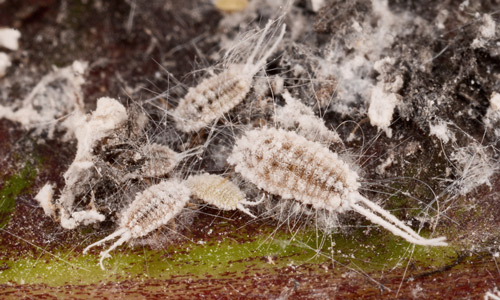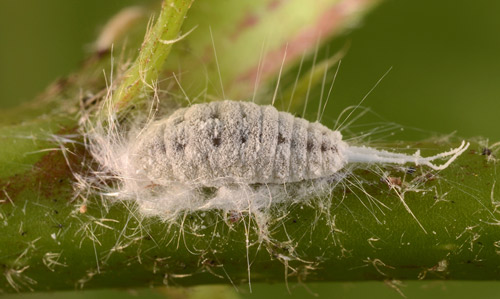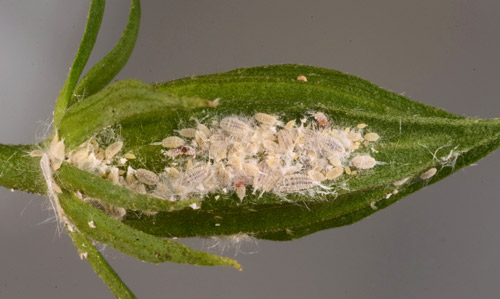common name: striped mealybug
scientific name: Ferrisia virgata Cockerell (Insecta: Hemiptera: Pseudococcidae)
Introduction - Synonymy - Distribution - Description - Biology - Host Plants - Damage - Management - Selected References
Introduction (Back to Top)
The striped mealybug, Ferrisia virgata Cockerell, is a small insect that is a pest of a broad range of plants. It has been unintentionally introduced across the globe through international trade. Mealybugs are sap-feeding insects that tap into the phloem via a piercing, straw-like mouthpart known as a stylet. Severe infestations of mealybugs can be fatal to a plant. Large populations of mealybugs appear as accumulations of white, cottony-looking wax on the plant. This wax is produced by special glands and gives the insects the “mealy” appearance from which the name “mealybug” is derived.
Synonymy (Back to Top)
Dactylopius virgatus
Pseudococcus marchali
Pseudococcus bicaudatus
Ferrisia virgata
Ferrisiana virgata
Ferrisia neovirgata
Distribution (Back to Top)
Ferrisia is a New World genus native to the Americas (Williams and Watson 1988). The striped mealybug is one of two Ferrisia species to spread to the Old World and it can now be found in tropical and temperate climates across the globe (Kosztarab 1996, Williams 2004, Williams and Granara de Willink 1992, Williams and Watson 1988). The striped mealybug has also achieved economic significance as a pest of several agricultural crops, including cocoa and cotton (Ameyaw et al. 2014, Kosztarab 1996, Oliveira et al. 2014).
Figure 1. Adult and immature female Ferrisia virgata Cockerell on croton. Photograph by Ariane McCorquodale, University of Florida.
Description (Back to Top)
In 2012, Kaydan and Gullan published a taxonomic review of the genus Ferrisia, and described several new species from specimens that were formerly classified as Ferrisia virgata. The authors proposed that Ferrisia virgata is a species complex consisting of several morphologically similar but genetically distinct species. For the purposes of this publication, the striped mealybug common name refers to members of the Ferrisia virgata complex.
The striped mealybug is named for the two dark, dorsal stripes that run longitudinally down its body. These stripes are visible on the mealybug cuticle through bare patches in the waxy covering (Figure 1). Length of the adult female body is approximately 2.0-4.5 mm (Kaydan and Gullan 2012). Additional identifying features of the striped mealybug are the two posterior waxy tails or tassels with a length half that of the mealybug body, the presence of crystalline, hair-like rods extending laterally from the body, and the absence of an ovisac (egg sac) (Ferris 1950).
First and second instar nymphs are light yellow with six antennal segments (Highland 1956). Third instar nymphs have seven antennal segments. Males begin to differentiate from females in the third instar when the body color turns dark and the body shape begins to resemble the adult form. Wing buds are present in third instar males. Faint dorsal stripes and small caudal tassels gradually become apparent in females with each molt. Adult males are heavily sclerotized, dark gray in color, winged, and have ten antennal segments (Figure 2). Adult females are greenish-yellow in color with two dorsal, dark gray stripes, and antennae with eight segments (Ferris 1950, Highland 1956, Kaydan and Gullan 2012).
Figure 2. Adult male and immature female Ferrisia virgata Cockerell on croton. Photograph by Ariane McCorquodale, University of Florida.
Ferrisia gilli Gullan, or Gill’s mealybug (Figure 3), is a native species that is indistinguishable from the striped mealybug in the field and is not a member of the Ferrisia virgata complex (Gullan et al. 2003). Ferrisia gilli is a pest in pistachio and almond orchards in California, where it is believed to have been introduced (Kaydan and Gullan 2012).
Figure 3. A female Gill’s mealybug, Ferrisia gilli Gullan, on the underside of a magnolia leaf. Photograph by Lyle J. Buss, University of Florida.
Biology (Back to Top)
The striped mealybug has three nymphal instars. At the end of the third instar the female molts into the sexually mature adult form. Males begin constructing a cocoon at the onset of the second instar and continue feeding and maturing while inside (Highland 1956). The third instar in males is a prepupa stage after which a puparia is formed. The male reaches sexual maturity upon the molt from puparia to the winged adult stage. Reproduction of the striped mealybug occurs sexually. Though the striped mealybug is not parthenogenic (a form of asexual reproduction), a closely related species, Ferrisia malvastra, is (Kaydan and Gullan 2012). Females do not produce ovisacs but construct “pads” made of waxy filaments (Figure 4). Eggs are deposited on the pad and the first instar nymphs hatch within a few hours (Awadallah et al. 1979b). There are three to five generations per year (Ammar et al. 1979, Awadallah et al. 1979b, Highland 1956).
Figure 4. Adult female Ferrisia virgata Cockerell with filamentous pad on hibiscus. Photograph by Lyle J. Buss, University of Florida.
Host Plants (Back to Top)
As a polyphagous species, the striped mealybug can be found on numerous hosts. Common hosts in Florida are copperleaf (Acalypha spp.), croton (Codiaeum variegatum), hibiscus (Hibiscus rosa-sinensis), seagrape (Coccoloba spp.) and citrus as well as popular home garden vegetables such as tomato, eggplant, and pepper (García et al. 2015, FDACS DPI database, personal communication). In addition to the hosts described previously, the striped mealybug is a pest of amaranth, cassava, ficus, magnolia, plumeria, silk tree (Albizia spp.), and sugar-apple (Annona spp.), as well as cocoa and cotton, upon which the striped mealybug has had economic significance (Ameyaw et al. 2014, Oliveira et al. 2014). For extensive host lists for Ferrisia spp. please visit http://scalenet.info/ (Ben-Dov 1994).
Damage (Back to Top)
Mealybugs affect nutrient levels in plants through sap-feeding, thereby reducing growth (Dreistadt 2001, Franco et al. 2009). Mealybugs often produce a substance that is sticky and high in carbohydrates known as honeydew. Honeydew is an excellent medium for the growth of sooty mold, a fungus that forms a dark film on the leaf surface and impairs photosynthesis. Large aggregations of mealybugs on plants appear as unsightly white, sticky masses of wax and individuals, which can render plants unmarketable (Figure 5). Leaf discoloration and leaf and fruit drop are also symptoms of mealybug infestations; however, symptoms will vary depending on plant species and plant health status.
Figure 5. Ferrisia virgata Cockerell infestation on hibiscus flower bud. Photograph by Lyle J. Buss, University of Florida.
The striped mealybug is known to vector plant pathogens, a trait uncommon in mealybugs. It has been reported to transmit Cocoa swollen shoot virus, Citrus tristeza virus, and Piper yellow mottle virus (Ameyaw et al. 2014, Bhat et al. 2003, Thorold 1975).
Management (Back to Top)
Cultural Control: Early detection provides the best chance at managing mealybugs due to the vulnerability of the immature stages (Dreistadt 2001, Franco et al. 2009). Carefully inspect purchased plants to avoid spreading mealybugs. Scout susceptible plants for mealybugs or masses of cottony wax. Mealybugs can be difficult to see with the naked eye and they often reside in cryptic or hidden locations such as the crooks of branches and undersides of leaves, which may appear distorted. If mealybugs are not apparent but an infestation is suspected, sooty mold and ant activity may also be clues to a mealybug or other honeydew-producing insect problem. Infested plants should be isolated or removed and disposed of immediately to prevent spread. In many commercial greenhouses, highly infested plants are destroyed because such infestations are very difficult to control.
Biological Control: For greenhouses, commercially available insects such as the mealybug destroyer (Cryptolaemus montrouzieri), green lacewings, and brown lacewings can be purchased to prevent mealybug outbreaks (Dreistadt 2001, Franco et al. 2009). Outdoors, these and other naturally present mealybug enemies can be conserved through avoidance of foliarly applied, broad-spectrum insecticides. Another consideration when using biological control agents for mealybug management is the presence of ants. Honeydew is very attractive to ants as a source of food. Some species of ants will defend mealybugs from predation and parasitism to protect their access to the honeydew. If it is suspected that ants are contributing to a mealybug infestation it is recommended to use insecticide baits, traps, or granules combined with barriers like sticky tape to prevent ants from hindering predation or other mealybug control efforts (Dreistadt 2001).
Chemical Control: Due to their waxy hydrophobic covering, managing mealybugs with pesticide sprays can be difficult (Dreistadt 2001, Franco et al. 2009). Contact insecticides are most effective when the younger stages are targeted. This is because first and second instar mealybugs are not protected by the dense waxy covering that develops in the later instars. Insect growth regulators (IGRs), insecticidal soaps, and horticultural oils are suggested for treating early instar mealybugs and can be applied directly to the plant and mealybugs. Systemic insecticides, which are applied to the soil and taken up into the plant by the roots, have also been shown to be effective. However, because mealybugs have overlapping generations, repeated, frequent applications are often necessary and this may hasten the development of insecticide resistance. Frequent pesticide use can also negatively impact beneficial insects.
Selected References (Back to Top)
- Ameyaw G, Dzahini-Obiatey H, Domfeh O. 2014. Perspectives on cocoa swollen shoot virus disease (CSSVD) management in Ghana. Crop Protection 65: 64-70.
- Ammar E, Awadallah K, Rashad A. 1979. Ecological studies on Ferrisia virgata CKLL. on Acalypha shrubs in Dokki, Giza (Homoptera, Pseudococcidae). Deutsche Entomologische Zeitschrift 26: 207-213.
- Awadallah K, Ammar E, Rashad A. 1979a. Description of immature stages of the white mealy-bug, Ferrisia virgata (CKLL.) (Homoptera, Pseudococcidae). Deutsche Entomologische Zeitschrift 26: 9-20.
- Awadallah K, Ammar E, Tawfik M, Rashad A 1979b. Life-history of the white mealy-bug Ferrisia virgata (CKLL.) (Homoptera, Pseudococcidae). Deutsche Entomologische Zeitschrift 26: 101-110.
- Bhat A, Devasahayam S, Sarma Y, Pant R. 2003. Association of a Badnavirus in black pepper (Piper nigrum L.) transmitted by mealybug (Ferrisia virgata) in India. Current Science 84: 1547-1550.
- Dreistadt SH. 2001. Integrated pest management for floriculture and nurseries. UCANR Publications.
- Ferris GF. 1950. Atlas of the Scale Insects of North America, Volume V: The Pseudococcidae (Part I). Stanford University Press.
- Franco JC, Zada A, Mendel Z. 2009. Novel approaches for the management of mealybug pests. Biorational Control of Arthropod Pests. Springer, pp. 233-278.
- García M, Denno B, Miller DR, Miller GL, Ben-Dov Y. 2015. ScaleNet: A literature-based model of scale insect biology and systematics. http://scalenet.info (22 December 2016)
- Gullan PJ, Kaydan M, Hardy NB. 2010. Molecular phylogeny and species recognition in the mealybug genus Ferrisia Fullaway (Hemiptera: Pseudococcidae). Systematic Entomology 35: 329-339.
- Gullan P, Downie D, Steffan S. 2003. A new pest species of the mealybug genus Ferrisia Fullaway (Hemiptera: Pseudococcidae) from the United States. Annals of the Entomological Society of America 96: 723-737.
- Highland HA. 1956. The biology of Ferrisiana virgata, a pest of azaleas. Journal of Economic Entomology 49: 276-277.
- Hodges A, Hodges G, Buss L, Osborne L. 2000. Mealybugs & Mealybug Look-alikes of the Southeastern United States, USDA/CSREES.
- Kaydan M, Gullan P. 2012. A taxonomic revision of the mealybug genus Ferrisia Fullaway (Hemiptera: Pseudococcidae), with descriptions of eight new species and a new genus. Zootaxa 3543: 1-65.
- Kosztarab M. 1996. Scale insects of northeastern North America: Identification, biology, and distribution. Virginia Museum of Natural History.
- Oliveira MD, Silva-Torres CS, Torres JB, Oliveira JEM. 2014. Population growth and within-plant distribution of the striped mealybug Ferrisia virgata (Cockerell) (Hemiptera, Pseudococcidae) on cotton. Revista Brasileira de Entomologia 58: 71-76.
- Thorold CA. 1975. Diseases of cocoa. Clarendon Press. Oxford.
- Williams DJ. 2004. Mealybugs of southern Asia. Natural History Museum jointly with Southdene.
- Williams DJ, Granara de Willink MC. 1992. Mealybugs of Central and South America. CAB International.
- Williams DJ, Watson GW. 1988. The Scale Insects of the Tropical South Pacific Region. Pt. 2: The Mealybugs (Pseudococcidae). CAB International Institute of Entomology, London. 260 pp.




